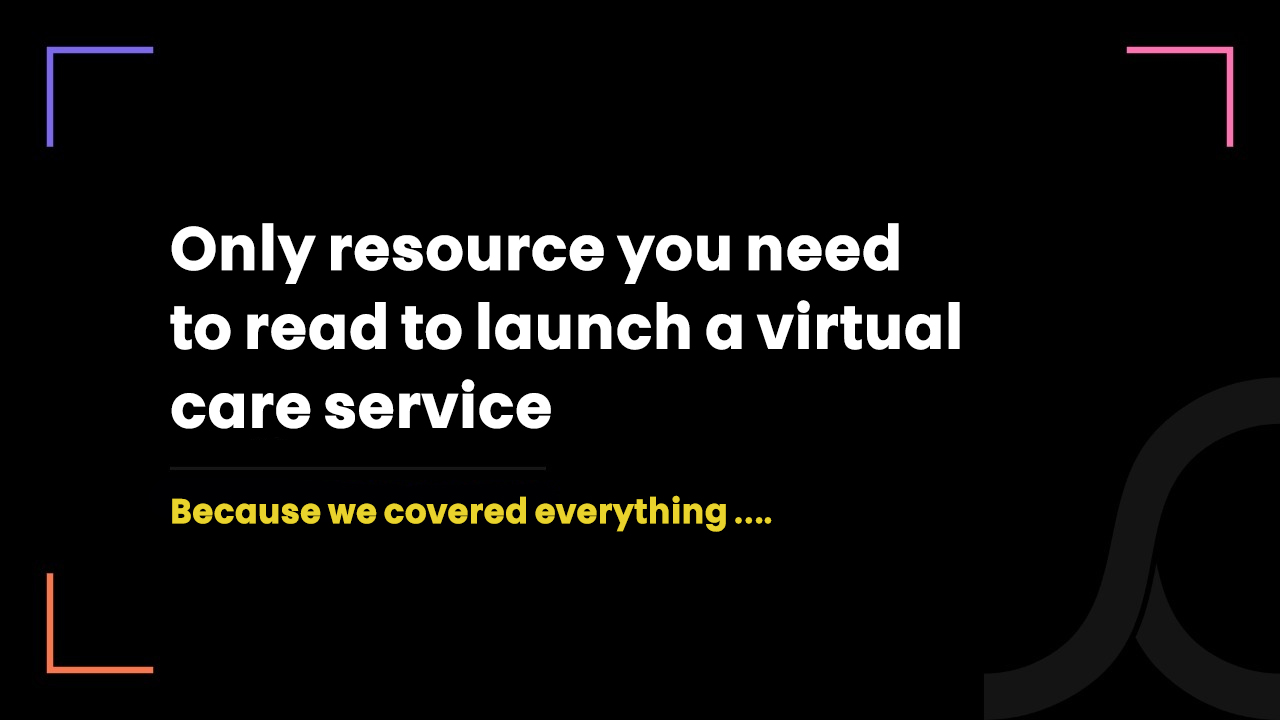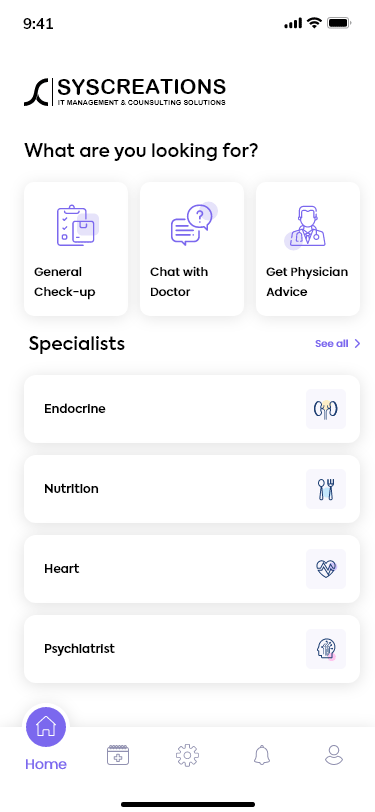How to Start a Virtual Care Service in Canada? A Checklist

4 years ago
COVID-19 pandemic has pushed virtual care or telemedicine from a trend to a mainstream care delivery model.
With patients preferring virtual medical consultation, providers leave with no choice but to start a virtual care service.
But due to technical, clinical and legal challenges, they either fail to launch virtual clinics or launch with a wrong telemedicine platform, ineffective clinical workflows and privacy issues.
So, to help you start a virtual care service without making any technical, clinical and legal blunders, we are outlining 10 critical workstreams you’ll need to plan.
Our other interesting resources on healthcare IT and automation:
- A guide to healthcare automation
- A guide to healthcare UI/UX
- Epic, Allscripts, Cerner EHR integration
- Would assessment tool working on AI technology
- Home care and wellness marketplace
If you’re wondering “How do I start a virtual clinic?”, Here is how …
1. Service coverage
Where will you launch your service?
First step is to determine in which Canadian province or territory you are going to start a virtual care service.
You can select a province and initiate a pilot in 3-5 high populated cities to test your virtual care program and evaluate operations.
Once you pilot it successfully and attract investors, you can plan a national rollout while keeping the risk minimum.
While deciding province for an initial launch, you must consider,
- Health card coverage: Does the health card of that province cover televisits?
(Only in Alberta, B.C. and Ontario, televisits are covered under health cards. In these provinces, you have to provide health card-covered virtual care.)
- Patient behaviour: Do patients of that province use telemedicine?
- Market competition: Are there any already performing virtual care providers?
- Legality: Is there any provincial-level data privacy law? If yes, what are its regulations?
2. Telemedicine platform
Which technology solution do you need?
Once you decide the province where you are going to start a virtual clinic, you need to decide which virtual care or telemedicine platform you’ll adopt.
But before deciding it, fix your maximum budget and ensure to not overshoot it.
Talking about a telemedicine platform, you’ll have several options.
- Custom telemedicine platform
- MVP telemedicine platform
- Cloned telemedicine platform
- White-label telemedicine platform without source code
- White-label telemedicine platform with source code
- White-label telemedicine platform with source code and customization
We have compared all of these options and suggested the most suitable platform in our dedicated blog.
Read it from here: Should you build or buy telemedicine tech infrastructure?
3. Clinical areas
Which clinical services will you offer?
People opt-in for telemedicine for all non-emergency medical services including specialized care and chronic care.
This is why it is important to map out specific clinical areas you want to focus on.
You can offer dermatology, rehabilitation, primary care, dental care or lifestyle care such as erectile dysfunction or women’s sexual health.
While deciding your clinical areas, you must consider following factors.
- Resources availability: Do you have access to enough healthcare providers?
- Health card coverage: Does a health card cover a service you provide? (Dental care is not covered under several health plans across Canada.)
- Patient behaviour: Do patients select virtual care for a clinical service you’re offering? (People don’t generally prefer virtual care for physiotherapy.)
4. Clinical protocols
What are clinical protocols in place for each clinical service?
Once you define clinical areas, you need to frame clinical protocol such as how will you intake patients? What are the details you will ask for on an intake form? What will be treatment strategy? How will you refer patients?
On its lowest level, clinical protocols must define,
- Patient history and physical (H & P)
- Patient symptoms
- Comorbidities
- Current medications
- Appropriate & approved medications for each treatment area
- Drug-drug interactions to avoid
- Potential drug side effects
- Contraindications
- Refill guidelines
5. ePrescription
How will you manage ePrescription?
Be it virtual care or in-person care, prescribing a patient is an important part of clinical workflow.
Thus, you have to build a capability to let providers write ePrescription on your virtual care platform itself.
You can offer them a choice to either write a custom ePrescription or select from available templates.
Additionally, you need to clearly outline clinicians who can write a prescription as per your clinical protocol and government regulations.
It is also advisable to showcase a list of commonly prescribed medications and banned or restricted medication that your service will not provide.
6. Prescription fulfillment
How will you fulfill a prescription?
To offer a 360-degree virtual care service, you have to ensure that patients get medication at their doorstep.
For that, you can tie up with white-labelled pharmacy fulfillment companies which are offering next-day or same-day doorstep delivery of medicines.
For patients who can manage to pick up prescriptions from their preferred nearby pharmacy, you should send prescriptions to that pharmacy directly.
7. 3rd party service integration
Which 3rd party services will you integrate for more streamlined operations?
You need to list out all 3rd party services you have to integrate with your telemedicine platform for enhancing its utility.
For instance, you have to integrate EMR/EHR to let providers access clinical data of patients from your telemedicine platform itself.
You have to integrate Telus eClaims to let providers submit claims directly to private medical insurance companies.
You should read this: How to integrate Telus eClaims?
You can also integrate your telemedicine platform with other healthcare marketplaces such as Oscar Pro marketplace, AthenaHealth marketplace to expand your user base.
8. Compliance readiness and legal protection
Are you compliant with data privacy laws and do you have legal protection?
It is mandatory to ensure your organization is compliant with data privacy laws and there is no privacy vulnerability within your entire organization including your telemedicine tech.
To find privacy vulnerabilities, you can carry out PIA and TRA. PIA reveals privacy vulnerabilities at organizational level whereas TRA reveals privacy vulnerabilities of a telemedicine platform.
One of the reasons why it is important to be compliant with privacy laws is that it almost eliminates scope for a data breach.
However, a data breach is still possible as new privacy vulnerabilities can emerge at any time.
So to be financially stable during such an adverse event, it is advisable to have cyber liability insurance. It covers the business cost of a data breach due to a virus or malicious cyberattack.
Check out our case study: How to execute PIA?
9. Virtual care workforce
How will you find and train clinicians for your virtual care program?
Building your highly-trained and qualified virtual care workforce is very crucial for the overall success of your virtual care service.
You can attract clinicians to facilitate virtual medical consultation through your platform by running partner programs and offering them unique value propositions.
You can also tie-up with large clinical centers to leverage their workforce for your virtual care service.
If they are qualified but not trained to navigate telemedicine tech efficiently, they cannot offer quality care and find themselves buried under tech complexities.
Thus, your focus should be centralized around making clinicians aware of every feature of a telemedicine app, clinical workflows and clinical protocols by running several trials.
10. Workforce management
How will you make sure there are always enough clinicians available for patients?
In addition to remote care, another popular use case of telemedicine is to offer rapid care to patients whenever they are seeking it.
Meaning, there should be clinicians available on your telemedicine platform every time and every day to ensure patients don’t have to wait.
But that does not mean you ask every clinician to remain active or online on your telemedicine platform all the time to offer rapid care to patients.
So, what’s the solution?
You can offer an appointment-only virtual care service. (But we don’t recommend this as patients don’t get rapid care with this approach.)
A more practical solution is leveraging AI and machine learning algorithms to forecast demand and plan your telehealth workforce accordingly.
Almost all on-demand service providers including Uber rely on a forecasting model working on AI & ML to satisfy consumer demand with an adequate supply of service providers.
But even with such advanced technology, you cannot forecast precisely.
In such cases, you need to deploy a symptom checker or virtual assistant which helps patients to know the cause of their symptoms and suggest next step.
Still nervous about launching your virtual care service? Here is how we can help you …
We are an Ontario-based team of telemedicine tech and compliance experts.
Our 7-year-old healthcare IT expertise and on-ground understanding of the Canadian healthcare system make us experts in the true sense.
We accommodate developers, designers, business experts and compliance specialists who all work together to solve all of your telemedicine tech, business and legal challenges.
We develop custom, clone and MVP type of telemedicine mobile and web-based solutions working on AI and machine learning technologies.
We also become your strategic business partner and offer you peace of mind by offloading all of your difficulties.
With our healthcare-specific experience, we build and deploy telemedicine solutions with a clear understanding of clinical workflows, protocols and compliance requirements.
We are well-aware of all clinical terms, operations and billing structures that make us deliver you telemedicine tech customized according to your clinical practice.
On a concluding note, we would like to share our white-label telemedicine platform which is compliant with all data privacy laws.

